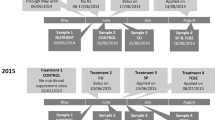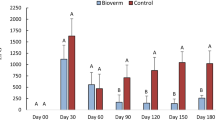Abstract
The effect of ivermectin excreted in faeces of cattle treated in late winter on the arthropods and the degradation of faeces on pasture were evaluated. Four calves of similar age and weight were allocated to two groups, one group was treated subcutaneously with ivermectin and the other group remained as untreated control. From faeces collected from both groups at 3, 7, 14, 21 and 28 days post-treatment (dpt), three faecal pats of 1 kg each were made and deposited on a mixed paddock. One quarter of each faecal pat was removed at 10, 20, 30 and 60 days postdeposition (dpd) to determine the concentration of ivermectin, the organic matter content, and to collect colonising dung arthropods. Concentrations at days 3 and 7 pt were significantly higher than at the other dpt (p < 0.05). The highest ivermectin concentrations were found in samples from 3 dpt (p < 0.05). The organic matter percentage was not significantly different between treatments. An edaphic fauna characterised the colonisation of the faeces by organisms. Although arthropods’ abundance differences were not significant except for the 28 dpt at 30 dpd (p < 0.0003), fewer organisms were collected from the ivermectin group at all times.




Similar content being viewed by others
References
Alvinerie M, Sutra JF, Galtier P, Lifschitz A, Virkel G, Sallovitz J, Lanusse C (1998) Persistence of ivermectin in plasma and faeces following administration of a sustained-release bolus to cattle. Res Vet Sci 66:57–61
Anziani OS, Fiel CA (2005) Resistencia de los nemátodos gastrointestinales a los antihelmínticos: un problema emergente y relevante para la producción bovina nacional. In Estudio de la resistencia a los antiparasitarios en Argentina. FAO, Producción y Sanidad Animal, Roma, pp 40–49
Boxall AB, Sherratt TN, Pudner V, Pope LJ (2007) A screening level index for assessing the impacts of veterinary medicines on dun flies. Environ Sci Technol 41:2630–2635
Celestina T, Gobec I, Kolar L, Cerkvenik Flajs V, Pogacnik M, Kožuh Eržen N (2010) Factors influencing dissipation of avermectins in sheep faeces. Ecotoxicol Environ Saf 73(1):18–23
Chiu SHL, Green ML, Baylis FP, Eline D, Rosegay A, Meriwether H, Jacob TA (1990) Absorption, tissue distribution, and excretion of tritium labeled ivermectin in cattle, sheep, and rat. J Agric Food Chem 38:2072–2078
Desière M (1973) Ecologie des coléopteres coprophages. Ann Soc R Zool Belg 103:135–145
Fiel CA, Saumell CA, Steffan PE, Rodriguez EM (2001) Resistance of Cooperia to ivermectin treatments in grazing cattle of the humid Pampa Argentina. Vet Parasitol 97:211–217
Floate KD (1998) Off-target effects of ivermectin on insects and on dung degradation in southern Alberta, Canada. Bull Entomol Res 88:25–35
Floate KD (2006) Endectocide use in cattle and fecal residues: environmental effects in Canada. Can J Vet Res 70:1–10
Floate KD, Fox AS (1999) Indirect effects of ivermectin residues across trophic levels: Musca domestica (Diptera: Muscidae) and Muscidifurx zaraptor(Hymenoptera: Pteromalidae). Bull Entomol Res 89:225–229
Floate KD, Gill BD (1998) Seasonal activity of dung beetles (Coleoptera: Scarabaeidae) associated with cattle dung in southern Alberta and their geographic distribution in Canada. Can Entomol 130:131–151
Floate KD, Colwell DD, Fox AS (2002) Reductions of non-pest insects in dung of cattle treated with endectocides: a comparison of four products. Bull Entomol Res 92:471–481
Floate KD, Wardhaugh KG, Boxall ABA, Sherrat TN (2005) Fecal residues of veterinary parasiticides: non target effects in the pasture environment. Annu Rev Entomol 50:153–179
Gover J, Strong L (1995a) The effects of ivermectin in ingested cow-dung on the mortality and oviposition of the dung fly Neomyia cornicina (Diptera: Muscidae). Bull Entomol Res 85:53–57
Gover J, Strong L (1995b) Effects of ingested ivermectin on body mass and excretion in the dung fly, Neomyia cornicina. Physiol Entomol 20:93–99
Halley BA, Jacob TA, Lu AYH (1989) The environmental impact of the use of ivermectin: environmental effects and fate. Chemosphere 18:1543–1563
Iglesias L (1998) Colonização de bolos fecais de bovinos tratados com ivermectin durante a época seca em condições simuladas de campo. Universidade Federal de Juiz de Fora (MG) Brasil, Dissertação de mestrado
Iglesias LE, Saumell CA, Fusé LA, Lützelschwab CM, Steffan PE, Fiel CA (2004) Patrón primaveral de colonización y permanencia de artrópodos en masas fecales de bovinos en la zona de Tandil, Argentina. Rev RIA 33:85–100
Iglesias LE, Saumell CA, Fernández AS, Fusé LA, Lifschitz AL, Rodríguez EM, Steffan PE, Fiel CA (2006) Environmental impact of ivermectin excreted by cattle in autumn on dung fauna and degradation of faeces on pasture. Parasitol Res 100:93–102
Jensen J, Krogh P, Sverdrup LE (2003) Effects of the antibacterial agents tiamulin, olanquindox and metronidazole and the anthelmintic ivermectin on the soil invertebrate species Folsomia fimetraria (Collembola) and Enchytraeus crypticus (Enchytraeidae). Chemosphere 50:437–443
Kolar L, Kožuh Eržen N (2007) Degradation of abamectin and doramectin in sheep faeces under different experimental conditions. Int J Environ Pollut 31:22–33
Krüger K, Scholtz C (1998a) Changes in the structure of dung insect communities after ivermectin usage in a grassland ecosystem. Acta Oecol 19(5):425–438
Krüger K, Scholtz C (1998b) Changes in the structure of dung insect communities after ivermectin usage in a grassland ecosystem. II Impact of ivermectin under high-rainfall conditions. Acta Oecol 19(5):439–451
Lifschitz A, Virkel G, Sallovitz J, Sutra JF, Galtier P, Alvinerie M, Lanusse C (2000) Comparative distribution of ivermectin and doramectin to tissues of parasite location in cattle. Vet Parasitol 87:327–338
Lumaret JP, Erroussi F (2002) Use of anthelmintics in herbivores and evaluation of risks for the non target fauna of pastures. Vet Res 33:547–562
Lumaret JP, Martínez I (2005) El impacto de productos veterinarios sobre insectos coprófagos: consecuencias sobre la degradación del estiércol en pastizales. Acta Zool Mex 21(3):137–148
Madsen M, Overgaard Nielsen B, Holter P, Pedersen OC, Brøchner-Jespersen J, Vagn-Jensen KM, Nansen P, Grønvold J (1990) Treating cattle with ivermectin: effects on the fauna and decomposition of dung pats. J Appl Ecol 27:1–15
Merritt RW, Anderson JR (1977) The effects of different pasture and rangeland ecosystems on the annual dynamics of insects in cattle droppings. Hilgardia 45:31–71
Mohr CO (1943) Cattle droppings as ecological units. Ecol Monogr 13(3):275–298
SAS Institute (1989) SAS/STAT User’s Guide, Version 6, vol 1, 4th edn. SAS Institute, Cary, p 943
Sommer C, Steffansen B (1993) Changes with time after treatment in the concentrations of ivermectin in fresh cow dung and in cow pats aged in the field. Vet Parasitol 48:67–73
Sommer C, Steffansen B, Overgaard-Nielsen B, Grønvold J, Vagn-Jensen KM, Brøchner-Jespersen J, Springborg J, Nansen P (1992) Ivermectin excreted in cattle dung after subcutaneous injection or pour-on treatment: concentrations and impact on dung fauna. Bull Entomol Res 82:257–264
Tullgren A (1918) Ein sehr einfacher Ausleseapparat fur terricole Tierformen. Z Angew Entomol 4:149–150
Valiela I (1974) Composition, food webs and population limitation in dung arthropod communities during invasion and succession. Am Mid Nat 92(2):370–385
Wall R, Strong L (1987) Environmental consequences of treating cattle with the antiparasitic drug ivermectin. Nature 327:418–421
Wardhaugh KG, Rodriguez Menendez H (1988) The effects of the antiparasitic drug, ivermectin, on the development and survival of the dung-breeding fly, Orthelia cornicina (F) and the scarabaeine dung beetles, Copris hispanus L., Bubas bubalus (Oliver) and Onitis belial F. J Appl Entomol 106:381–389
Wardhaugh KG, Longstaff BC, Morton RA (2001) A comparison of the development and survival of the dung beetle, Onthophagus taurus (Schreb.) when fen on the faeces of cattle treated with pour-on formulations of eprinomectin or moxidectin. Vet Parasitol 99:155–168
Acknowledgement
We thank Raúl Rivas and Juliano Schirmbeck for technical and instrumental assistance. We are grateful to Juan Manuel Sallovitz for their valued suggestion on this manuscript
Author information
Authors and Affiliations
Corresponding author
Rights and permissions
About this article
Cite this article
Iglesias, L.E., Fusé, L.A., Lifschitz, A.L. et al. Environmental monitoring of ivermectin excreted in spring climatic conditions by treated cattle on dung fauna and degradation of faeces on pasture. Parasitol Res 108, 1185–1191 (2011). https://doi.org/10.1007/s00436-010-2161-y
Received:
Accepted:
Published:
Issue Date:
DOI: https://doi.org/10.1007/s00436-010-2161-y




